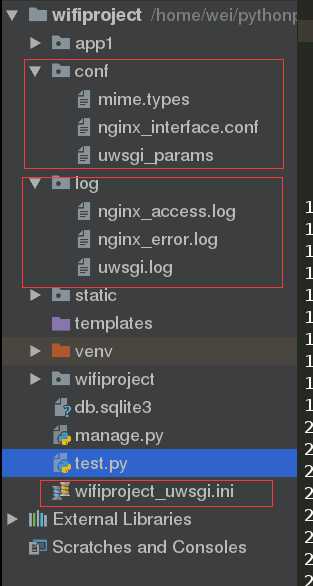Centos7下搭建Django+uWSGI+nginx基于python3
2021-06-16 06:03
标签:需要 configure als 命名 通信 日志 another down list Centos7 + python3.6 + virtualenv 由于centos自带的是python2.7版本,所以要自己安装新的版本,这里就不对此描述了,直接开工 因为我们没有事先安装Django,直接用pycharm创建新的Django项目,指定我们刚才的虚拟环境pycharm会在这个环境下自动安装较新版本的Django,如果需要指定版本可以先用pip安装到虚拟环境,创建时项目,指定虚拟环境。 使用manager.py Task 工具测试一下项目,runserver,浏览器访问一下我们的admin 没有毛病继续下一步操作 然后浏览 http://127.0.0.1:8000,有”Hello World”输出即安装成功。 说明uWSGI没有毛病,接下一步 uwsgi支持ini、xml等多种配置方式,本文ini为例, 在项目下新建wifiproject_uwsgi.ini,添加如下配置: 进入到 /usr/local/nginx 安装目录下 把这三个文件分别复制拷贝到项目的conf文件夹,也可以重命名 然后对nginx.conf配置文件进行设置 这样 就不会在终端打印日志了 settings.py 中设置debug = False ,Django将不会代管静态文件,我们是交给nginx管理,所以要把django的相关静态文件收集到一个目录下,并在nginx的配置文件里指向该目录 settings.py 添加 STATIC_ROOT = os.path.join(BASE_DIR,‘static‘) 调用manage命令 collectstatic 就会自动把相关静态文件收集到上面的路径里 使用虚拟环境进入项目 然后运行 如果没有报错就开启了uwsgi Centos7下搭建Django+uWSGI+nginx基于python3 标签:需要 configure als 命名 通信 日志 another down list 原文地址:https://www.cnblogs.com/Thomas-blog/p/8998670.html1.电脑环境
2.具体流程
使用python虚拟环境
1.在自己想要创建虚拟环境的文件夹下创建虚拟环境,我们的uWSGI也是安装在虚拟环境中
1 virtualenv Env
2 cd Env
3 cd bin
4 启动虚拟环境 source activate (关闭的命令 deactivate)
2.启动之后会看到命令行左边有括号括起的环境名称
1 pip3 install uwsgi 安装uwsgi库
3.安装pycharm
1 直接用浏览器下载tar.gz包
2 解压 tar xzvf xxx.tar.gz -C 指定解压到的目录
3 进入该目录
4 cd bin/
5 sh pycharm.sh
就开启了pycharm4.创建django项目
5.测试uWSGI,在项目下创建一个test.py文件
1 def application(env, start_response):
2 start_response(‘200 OK‘, [(‘Content-Type‘,‘text/html‘)])
3 return "Hello World"
运行 sudo uwsgi --http 0.0.0.0:8000 --wsgi-file test.py
6.下载nginx并安装
1 wget http://nginx.org/download/nginx-1.13.10.tar.gz
2 进入下载目录,解压 tar xzvf nginx-1.13.10.tar.gz
3 进入解压目录 cd nginx-1.13.10
4 ./configure --prefix=/usr/local/nginx #把所有资源文件放在/usr/local/nginx的路径中,不会杂乱。
5 make
6 make install7. 配置uwsgi
#wifiproject_uwsgi.ini file
[uwsgi]
#与nginx通信
socket = 127.0.0.1:8080
#让uwsgi作为单独的web-server,这里注释掉
#http = 127.0.0.1:8080
#django项目根目录
chdir = /home/wei/pythonproject/wifiproject
#wsgi.py在项目中的位置
module = wifiproject.wsgi
enable-threads = true
#进程数
processes = 4
#线成
threads = 2
#退出时清空环境变量
vacuum = true
#配uWSGI搜索静态文件目录,(及django项目下存放的static文件目录,用uwsgi作为单独服务器时才需要设置,此时我们用nginx处理静态文件
#check-static = /home/wei/pythonproject/wifiproject
#日志存储路径
daemonize = /home/wei/pythonproject/wifiproject/log/uwsgi.log
8. 配置nginx
1 user root; #使用root否则静态文件可能加载失败
2 worker_processes 1; #运行nginx工作进程,一般几个cpu核心就写ji
3
4 #error_log logs/error.log;
5 #error_log logs/error.log notice;
6 #error_log logs/error.log info;
7
8 #pid logs/nginx.pid;
9
10
11 events {
12 worker_connections 1024; #一个进程能同时处理1024个请求
13 }
14
15
16 http {
17 include mime.types;
18 default_type application/octet-stream;
19
20 #log_format main ‘$remote_addr - $remote_user [$time_local] "$request" ‘
21 # ‘$status $body_bytes_sent "$http_referer" ‘
22 # ‘"$http_user_agent" "$http_x_forwarded_for"‘;
23
24 #access_log logs/access.log main;
25
26 sendfile on;
27 #tcp_nopush on;
28
29 #keepalive_timeout 0;
30 keepalive_timeout 65;
31
32 #gzip on;
33 #开始配置一个域名,一个server配置一般对应一个域名
34 server {
35 listen 8002; #暴露给外部的端口,等于浏览器访问的端口
36 server_name localhost; #域名
37 charset utf-8;
38 error_log /home/wei/pythonproject/wifiproject/log/nginx_error.log;
39 access_log /home/wei/pythonproject/wifiproject/log/nginx_access.log;
40 #可以有多个location
41 location / {
42 #root html; #站点根目录
43 #index index.html index.htm; #索引文件
44 include /home/wei/pythonproject/wifiproject/conf/uwsgi_params; #设置将所有请求转发给uwsgi服务器处理
45 uwsgi_pass 127.0.0.1:8080; #指定uwsgi的url,与uwsgi通信
46
47 }
48 location /static/ {
49 #设置将/static的静态请求交给nginx,并指定静态文件的目录
50
51 alias /home/wei/pythonproject/wifiproject/static/;
52 }
53
54
55 #error_page 404 /404.html;
56
57 # redirect server error pages to the static page /50x.html
58 error_page 500 502 503 504 /50x.html;
59 #定义页面错误,如果出现这些错误,把站点根目录下的50x.html返回给用户
60 location = /50x.html {
61 root html;
62 }
63
64 # proxy the PHP scripts to Apache listening on 127.0.0.1:80
65 #
66 #location ~ \.php$ {
67 # proxy_pass http://127.0.0.1;
68 #}
69
70 # pass the PHP scripts to FastCGI server listening on 127.0.0.1:9000
71 #
72 #location ~ \.php$ {
73 # root html;
74 # fastcgi_pass 127.0.0.1:9000;
75 # fastcgi_index index.php;
76 # fastcgi_param SCRIPT_FILENAME /scripts$fastcgi_script_name;
77 # include fastcgi_params;
78 #}
79
80 # deny access to .htaccess files, if Apache‘s document root
81 # concurs with nginx‘s one
82 #
83 #location ~ /\.ht {
84 # deny all;
85 #}
86 }
87
88
89 # another virtual host using mix of IP-, name-, and port-based configuration
90 #
91 #server {
92 # listen 8000;
93 # listen somename:8080;
94 # server_name somename alias another.alias;
95
96 # location / {
97 # root html;
98 # index index.html index.htm;
99 # }
100 #}
101
102
103 # HTTPS server
104 #
105 #server {
106 # listen 443 ssl;
107 # server_name localhost;
108
109 # ssl_certificate cert.pem;
110 # ssl_certificate_key cert.key;
111
112 # ssl_session_cache shared:SSL:1m;
113 # ssl_session_timeout 5m;
114
115 # ssl_ciphers HIGH:!aNULL:!MD5;
116 # ssl_prefer_server_ciphers on;
117
118 # location / {
119 # root html;
120 # index index.html index.htm;
121 # }
122 #}
123
124 }
9 创建相关日志文件

10 生产模式下diango设置
11. 使用配置文件开启 uwsgi

12 在nginx启动目录下使用配置文件开启 nginx

13 使用浏览器访问
文章标题:Centos7下搭建Django+uWSGI+nginx基于python3
文章链接:http://soscw.com/index.php/essay/94456.html